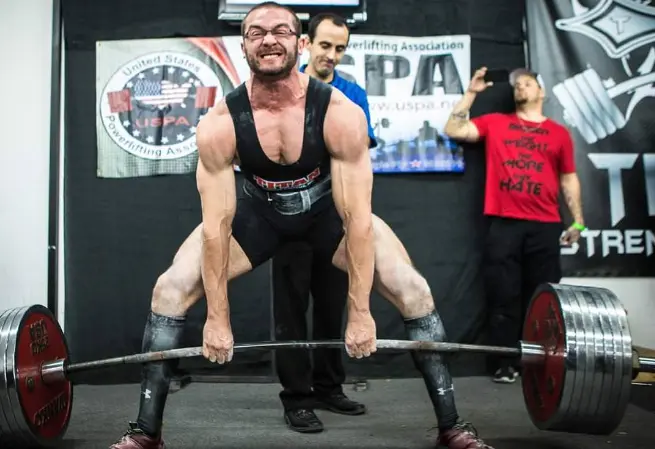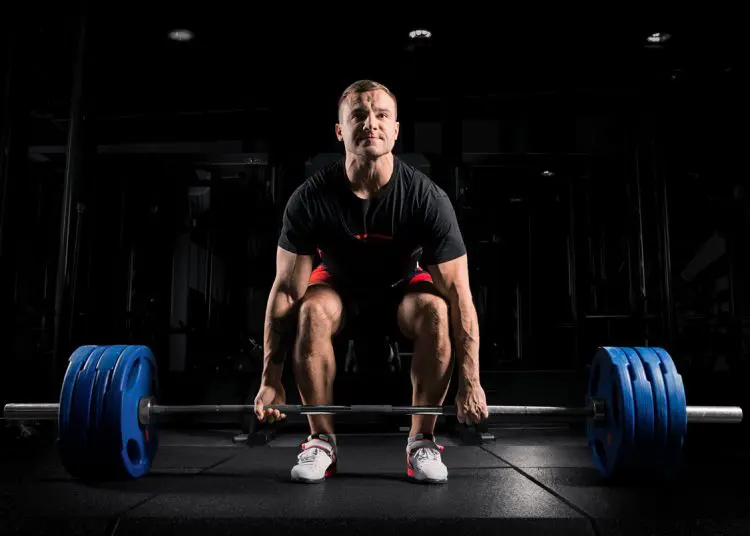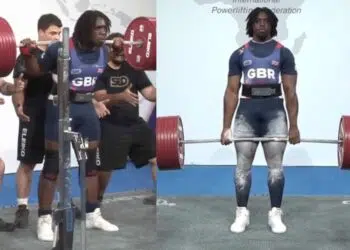What is Conjugate Training?
Conjugate training has been around for a very long time. The Soviets and Russians used Conjugate-style training with their Olympians and they did a lot of research not only on how to build strength, they also identified different types of strength like speed strength and absolute strength that could be specifically targeted depending on the needs of the athlete.
Conjugate training in the United States was primarily made popular by Louie Simmons, owner of WestSide Barbell in Columbus Ohio. Louie studied and implemented the system with himself and training partners by actually ordering and reading textbooks that were translated from Russian. Its popularity spread as they started to dominate the competition everywhere they went and now, you can find a fantastic documentary on the history of the man, the gym, and the legacy called “WestSide vs. The World.” I would highly recommend it at the very least to know and understand a significant part of powerlifting history.

Like any programming style, conjugate can get complicated very quickly. But it doesn’t need to be. This is all about how to keep it simple and get the most out of the program to make you stronger.
That’s why we’re all here anyway right?
Basic Overall Structure
The conjugate system is a just that, a conjugated approach that brings together multiple methods of training to raise all athletic skills at the same time. Other types of training, such as block training, Western Periodization, or a basic progressive overload style, usually focuses on one trait at time.
The problem with this is while you are building a specific athletic trait, the other ones are slowly diminishing. Conjugate brings everything together during a week-long layout designed to keep all levels of fitness up and not crush you in the process.
Level Up Your Fitness: Join our 💪 strong community in Fitness Volt Newsletter. Get daily inspiration, expert-backed workouts, nutrition tips, the latest in strength sports, and the support you need to reach your goals. Subscribe for free!
Max Effort Work (ME Work)
Max effort work is exactly what it is sounds like: a workout where you are going to lift with maximal effort. The theory is that to lift maximal weights, you have to practice lifting maximal weights. It sounds obvious but stick with me.
When using a basic, progressive overload program, the percentages tend to stay in the low- to mid-80%s up to about 92%. You build the work capacity and strength there and go above 93% on very rare occasions.
One of the primary issues with this approach is that there is an assumption your percentages are always accurate. It doesn’t take into account if you didn’t sleep last night, your eating was bad, you went out last night, or a billion other factors that will just make you feel “off” that day. While the program may call for you to lift 3 reps at 80%, a bad day can make that 80% feel like it’s 95%.
The second problem is that, when the weights get above 93%, things start to change a bit. The pressure on your entire body just picking the weight out of the rack is intense, the strain as you start moving can be terrifying, and the psychological aspect can break you before you even put your hands on the bar because you’ve never touched that weight before.
Max effort work takes you into those places weekly. Not only does your body get used to the feeling and the pressure, your psychology gets used to being under big weights because it’s just what you do every week. Depending on the variation of the main lift you are using, you might even be using weights above your 1RMs. This has a huge psychological benefit when at a meet or when attempting a new PR because you’ve already used and felt that weight before. It’s just another day of lifting weights.
There are a few goals on ME day that the athlete is trying to hit and one of them is to strain. Now when I say strain, it means you should have to fight to get whatever rep you are working for in that moment. To keep it simple, it’s a squat that you go down with and, as you come up, it slows right down and you have a bit of an “Uhh oh” moment.
The reason behind this strain goal is that it teaches you how to think in that situation. Having to make a small adjustment when the bar gets close to stopping can be the difference between making the lift and having your training partners peel you out from under it. Learning how to think and adjust when you are under a maximal load is a skill that has to be practiced and honed just like anything else.
The second goal is to work up to something with technical proficiency. Technique is something that will make or break your big lifts and drilling it over and over will keep you in the sport for a long time. A max-effort lift is considered done when you literally can’t lift any more weight, you fail a lift, or you can’t overcome a technical fault.
Let’s say that you’re deadlifting and you are really working on keeping your lower back flat at the start of your pull. No matter what number you have pulled in the past, if you can’t keep your back flat after a certain weight, you shut it down. Maybe you pulled 405 once and it was … not the best looking lift. That’s fine but, if you get to 315 and you start to lose your back position, that is where you stop the main lift for the day and move on to the secondary and accessory work.
Dynamic Effort Work (DE Work)
Strength is one thing, speed is a different animal. While maximal strength is all about the firing of every motor units possible in a muscle, dynamic strength (or speed strength) is about firing everything fast.
Level Up Your Fitness: Join our 💪 strong community in Fitness Volt Newsletter. Get daily inspiration, expert-backed workouts, nutrition tips, the latest in strength sports, and the support you need to reach your goals. Subscribe for free!

The best example of an explosive lifter I can ever think of is Cailer Woolam. He is the current holder of the 198 deadlift record at 958 pounds. This record was held for many years by the great Ed Cohen. By far, the most explosive deadlift I’ve ever seen.
Dynamic effort work is important to the conjugate system for two main reasons.
First, it actually gives your body a little bit of a break. On the max effort days, you lift really, really, heavy. This is going to beat you up a bit, make you tired, and fry your nervous system. You can’t just lift heavy all the time or you will run into a wall very quickly. Dynamic work is all about speed so it rarely gets above around 65%.
Dynamic work is generally programmed on a 3-week wave. The first week is done at around 50%, second week at 55%, and the third week at 60%. Depending on what you choose, you’ll either repeat those exact numbers for the next three weeks or change a variable in the lift like more or less bands, maybe a different bar, or something else.
The obvious questions: How does lifting at 50-60% make us faster? Well, the goal here is to make every rep as fast and technically accurate as possible and staying in absolute control the entire time. By adding that speed to the rep, you will fire everything fast, which will give you momentum to get through your sticking points when things get heavy.
Just because the weights are light doesn’t mean it will be easy. The sets in speed work start around 10 and, depending on the cycle, I’ve done up to 25 sets, all with about 30-60 seconds of rest. If done right, some people even say that speed days are harder then max effort days.
Repetition Effort Work (Rep Work)
Max effort and speed work are both for the main movement of the day, which is going to be some variation of the squat, bench, or deadlift. These give you ample opportunity to hone technique under both maximal weights and moving the bar as quickly as possible. Technique is a huge part of the conjugate systems because, if you are doing things wrong, you are going to put stress on your body where it shouldn’t be and that only lasts for so long.
After the primary work is done with the ME or DE day, then we get into the accessories of the session. This is where the repetition work comes in.
Where the ME and DE work is meant to practice the movement, repetition work is meant to bring up the weak points. We all have them. None of us like them. The best way to get rid of them is to train them until they are strong.
Let’s look at an example of a squat workout and assume that, about half to three-quarters of the way up, your mid- and upper-back start to round forward. During the ME work of that day, your goal is to keep that from happening for as long as possible. Squeeze it hard, have people cue you, and fight to keep it in place. As soon as it starts to happen, I usually suggest to maybe do one more set, see if you can fix it. If it happens again or gets worse, that’s where you stop that movement for the day.
Then you move on to the rep work where you hammer that mid and upper back to get it stronger with barbell rows, machine rows, reverse flys, just about anything you can think of to get it stronger and optimize that position so the rounding doesn’t become the thing that holds you back.
What Does This all Look Like?
Let’s get super practical now. Below is a basic, 3-week progression so you can see where everything is and how it is structured. While the accessory work doesn’t change, you sill want to progress week to week. This means you either want to try and use a heavier weight each week, add a few reps or another set, or maybe do the reps a little slower.
Try to make them a little harder every week so your body will keep adapting.
Week #1
Sunday: ME Upper
- Max Bench for 2 reps to a 2 board
- Close Grip DB Bench 5×10
- DB Shoulder Press 5×10
- Lat Pulldowns 5×8
- Pushups 75 in as few sets as possible
Monday
- Off
Tuesday
- Off
Wednesday: DE Lower
- Squats against red bands 10×2@50%
- DB Romanian Deadlifts 4×8
- Leg Press 3×8
- Leg Extensions 4×12-15
- Cossack Squats 3×8 each side
- 45º Back Raises 4×10
Thursday: DE Upper
- Bench against red bands 10×2@50%
- DB Floor Press 4×8
- Low Cable Row 3×12
- Inverted Rows 4×12
- 1-Arm OH Tricep Extensions 4×10 6) Barbell Front Raises 3×10
Friday
- Off
Saturday: ME Upper
- Reverse band squatsdouble 2@100%
- Chest Supported Rows 5×12
- Goblet Squats 4×14
- Walking Lunches 3×20/leg
- Reverse Flys 120 in as few sets as possible
Week #2
Sunday: ME Upper
- Max Bench single to a 2-board
- Close Grip DB Bench 5×10
- DB Shoulder Press 5×10
- Lat Pulldowns 5×8
- Pushups 75 in as few sets as possible
Monday
- Off
Tuesday
- Off
Wednesday: DE Lower
- Squats against red bands 10×2@55%
- DB Romainian Deadlifts 4×8
- Leg Press 3×8
- Leg Extensions 4×12-15
- Cossack Squats 3×8 each side
- 45º Back Raises 4×10
Thursday: DE Upper
- Bench 10×3@55%
- DB Floor Press 4×8
- Low Cable Row 3×12
- Inverted Rows 4×12
- 1-Arm OH Tricep Extensions 4×10
- Barbell Front Raises 3×10
Friday
- Off
Saturday: ME Upper
- Reverse band squat single @100-105%
- Chest Supported Rows 5×12
- Goblet Squats 4×14
- Walking Lunches 3×20/leg
- Reverse Flys 120 in as few sets as possible
Week #3
Sunday: ME Upper
- Max Bench double to a – board
- Close Grip DB Bench 5×10
- DB Shoulder Press 5×10
- Lat Pulldowns 5×8
- Pushups 75 in as few sets as possible
Monday
- Off
Tuesday
- Off
Wednesday: DE Lower
- Squats against red bands 10×2@60%
- DB Romainian Deadlifts 4×8
- Leg Press 3×8
- Leg Extensions 4×12-15
- Cossack Squats 3×8 each side
- 45º Back Raises 4×10
Thursday: DE Upper
- Bench 10×3@60%
- DB Floor Press 4×8
- Low Cable Row 3×12
- Inverted Rows 4×12
- 1-Arm OH Tricep Extensions 4×10
- Barbell Front Raises 3×10
Friday
- Off
Saturday: ME Upper
- Back Squat (no bands) up to heavy single
- Chest Supported Rows 5×12
- Goblet Squats 4×14
- Walking Lunches 3×20/leg
- Reverse Flys 120 in as few sets as possible
Read also
- 5 Essential Candito Training Programs For Powerlifters
- Developing Your Deadlift With The Ed Coan Routine
- The Cube Method: Improve Your Powerlifting Performance
- The Bulgarian Squat Method
- nSuns 531 LP Powerlifting Program Guide with Spreadsheets
Things to Remember
Like I said in the beginning, I’m biased when it comes to programming. To me and the lifters I program for, conjugate keeps things exciting. The variety is interesting and can be tailored to exactly what is needed, and it’s just fun for the effort you get to put it.
If you can be honest with what your weak points are and want something that is simple in it’s outline, I would highly encourage you to take conjugate for a ride. It’s like riding a bull. You will be humbled but you might also end up enjoying just about every part of it.













